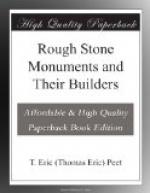Such a presumption is not weakened by the fact that in Sicily the usual form of tomb was the rock-hewn sepulchre, which, as will be seen later, is very often a concomitant of the megalithic monument, and in many cases is proved to be the work of the same people. In the early neolithic period in Sicily, called by Orsi the Sicanian Period, rock-hewn tombs seem not to have been used. It is only at the beginning of the metal age that they begin to appear. In this period, the so-called First Siculan, the tomb-chamber was almost always circular or elliptical, entered by a small door or window in the face of the rock. The dead were often seated round the wall of the chamber, evidently engaged in a funerary feast, as is clear from the great vase set in their midst with small cups for ladling out the liquid. A single tomb often contained many bodies, especially in cases where the banquet arrangement was not observed; one chamber held more than a hundred skeletons, and it has been suggested that the bodies were only laid in the tomb after the flesh had been removed from the bones, either artificially or as the result of a temporary burial elsewhere. Such a custom is not unknown in other parts of the megalithic area. With these bodies were found large quantities of painted pottery, a few implements of copper and many of flint. Among the ornaments which the dead carried—for they seem to have been buried in complete costume—were several axe-shaped pendants of polished stone, precisely similar to those of Sardinia, Malta, and France. The most important cemeteries of this period are those of Castelluccio, Melilli, and Monteracello. Near this last site was also found a round hut based on a course of orthostatic slabs of typically megalithic appearance.
In the full bronze age, called the Second Siculan Period, burial in rock-tombs still remained the rule. The tomb-form had developed considerably. The circular type was still usual, though beside it a rectangular form was fast coming into favour. The main chamber often had side-niches, and was usually preceded by a corridor which sometimes passed through an antechamber. Occasionally we find an elaborate open-air court outside the facade of the tomb, built very much after the megalithic style. Large vertical surfaces of rock were carefully sought after for tombs, and the almost inaccessible cliffs of Pantalica and Cassibile are literally honeycombed with them. Where such surfaces of rock were unobtainable a vertical shaft was sunk in the level rock and a chamber was opened off the bottom of it. The tradition of the banquet of the dead is still kept up, but the number of the skeletons in each tomb steadily decreases. The sitting posture is still frequent, though occasionally the body lies flat on one side with the legs slightly contracted. Flint is now rare, but objects of bronze are plentiful. The local painted pottery has almost entirely given place to simpler yet better wares with occasional Mycenean importations.




